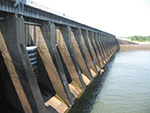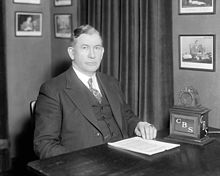 Kentucky Dam and electric energy played a key part in economic development.
Editor's Note: The Fall of Kentucky's Rock: Western Kentucky Democratic Politics Since the New Deal was selected for a 2022 Kentucky History Award, presented by the Kentucky Historical Society. Congratulations, George!
In many ways, western Kentucky in the first several decades of the 20th century life was little changed from that of the 19th century. The late Kentucky historian Thomas D. Clark pointed out the isolation of rural Kentucky. In the case of western Kentucky (including Hancock, Ohio, Butler, Warren, and Simpson counties and counties west of them), the unbridged Mississippi, Ohio, Tennessee, Cumberland and Green Rivers and the prevalence of unpaved roads made travel for residents difficult and sometimes dangerous. The vast majority of homes, particularly those of farming families, modern conveniences such as electricity, telephones, and indoor plumbing were absent.
My new book, The Fall of Kentucky's Rock: Western Kentucky Democratic Politics Since the New Deal published by the University Press of Kentucky, tells the story of local leaders in combination with federal and state initiatives aimed at improving life in the rural South. Applying strategies used to secure locations for several routes during the Good Roads Movement before the First World War, business leaders from Paducah formed the Kentucky Free Bridge Association, which with the backing of the Paducah Sun-Democrat and the Kentucky Farm Bureau, helped lower tolls in the region constructed in the late 1920s and 1930s to pay for bridges over the region's major rivers. Other groups were formed to promote the location of the major federal highways built through western Kentucky.
No more important event in the history of the region was the fight between public and private power interests in bringing electricity to the businesses, homes, and farms in western Kentucky. The struggle was joined over the construction of Kentucky Dam. Creation of the Tennessee Valley Authority (TVA) was one of the major New Deal programs. A series of dams on the Tennessee River had been constructed below the Kentucky-Tennessee line, before plans were drawn for what was to be the largest of the TVA dams. Behind the leadership of Luther Draffen, a Marshall County businessman and leading spokesman for the Lower Tennessee Valley Association, final plans called for a "high dam" suitable to address the hydroelectric, navigation, flood control, and recreational benefits that would have been compromised by a series of smaller dams. With the strong support of Paducah U.S. Senator Alben W. Barkley, Senate Majority Leader from 1938-46, and First District Congressman Noble Gregory from Mayfield, dam proponents defeated the determined opposition of public power interests in Kentucky and their supporters from the coal industry. The dam was completed in 1944, impounding the Tennessee River to create Kentucky Lake, one of the nation's largest manmade lakes.
Though supporters looked forward to the benefits the new dam would provide local citizens in terms of cheaper electric rates, state politics soon stood in the way. Private power interests sought to protect its interest in the courts which ruled against Kentucky municipalities contracting with TVA for electricity. The fight spilled over into the Kentucky legislature. Western Kentucky municipalities banded together to form the Kentucky Public Power League, and with the support of the Kentucky Farm Bureau the Kentucky League of Cities, and rural electric cooperatives (created by the New Deal) backed the pugnacious Henry Ward's determined stand to enact legislation giving municipalities the right to use TVA power. Ward, a reporter for the Paducah Sun-Democrat, had honed his skills as a young man fighting organized gaming in Paducah and taking a leading role in the free bridge movement. He was public power champion in the Kentucky general assembly.
The fight came down to winning the support of Governor Keen Johnson in the 1942 session of the general assembly. In a very public manner, Johnson recognized the importance that cheap energy would be to western Kentucky and sided with Ward against the chair of the Kentucky Public Service Commission and Kentucky Utilities. Ward, along with House Speaker Harry Lee Waterfield from Hickman County, were forced to beat back later determined public power efforts to greatly increase the costs to municipalities wishing to contract with TVA, but the region ultimately benefitted tremendously from the low-cost energy resulting in significant economic development of the region. Ward went on to earn recognition as the father of the Kentucky state parks system, including the development of Kentucky Dam Village and Kenlake State Parks on Kentucky Lake during the administrations of Governors Earle C. Clements and Lawrence Wetherby before taking on the development of interstate highways and parkway systems during the Combs and Breathitt administrations.
The development of the public power system in western Kentucky was critical to the development of the region. The availability of cheap, abundant electricity was a key to the federal government's location of the massive uranium enrichment (atomic bomb) facility outside Paducah in the early 1950s. Some suggest the choice to locate in Paducah was influenced by Vice President Alben W. Barkley, (shown at right), the former US senator from Paducah. The plant employed tens of thousands in the construction phase and when operational used nearly 4% of the nation's electricity capacity when it went on line. The plant's electricity needs stimulated coal production from the nearby West Kentucky Coal Field. With Congress, with the backing of the local Green River Valley Citizens League, directing millions of dollars into improving navigation of the lower Green River, area coal mines increased significantly coal production. Coal transportation on the Green River exploded from 350,000 tons in 1946 to 9 million tons in 1959. TVA built its largest coal fire plant in Muhlenberg County. 
These developments helped secure Democratic Party control in western Kentucky, at the time known as the Rock of Kentucky Democracy. The region provided large Democratic majorities in gubernatorial elections so that only two Republicans were elected from 1931 to 2003. Seven governors (Albert Benjamin "Happy" Chandler served two terms) were from western Kentucky.
By the end of the 20th century, the uranium enrichment plant's role in the country's defense effort was past and the coal industry was in a decline. Politics became more focused on social issues to the benefit of the Republican Party. It took control of both the congressional districts in western Kentucky in the 1994 elections. New leaders with a new vision for western Kentucky need to emerge to take on the challenges of the new millennium.
For more western Kentucky history see George G. Humphreys' newly published The Fall of Kentucky's Rock: Western Kentucky Democratic Politics Since the New Deal from University Press of Kentucky www.kentuckypress.com//9780813182339/the-fall-of-kentuckys-rock. |








